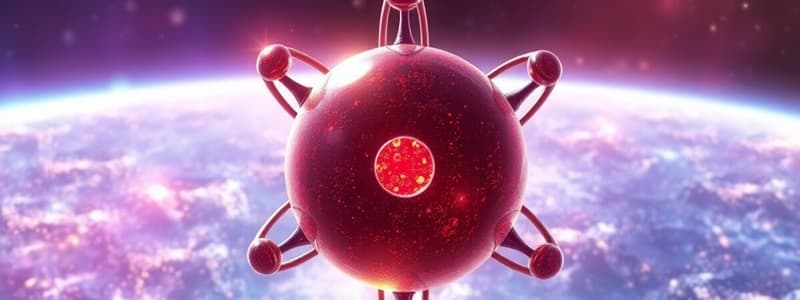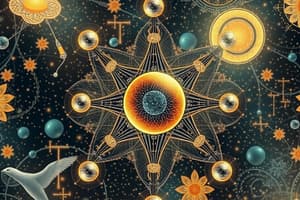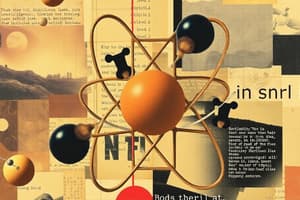Podcast
Questions and Answers
Identify the group on the periodic table that contains elements with 7 electrons in their outer shell.
Identify the group on the periodic table that contains elements with 7 electrons in their outer shell.
Group 7 (Halogens)
What is the valency of elements in Group 5?
What is the valency of elements in Group 5?
3
Name a property shared by all elements in Group 0 (Noble Gases).
Name a property shared by all elements in Group 0 (Noble Gases).
They are all gases at room temperature.
Explain why Alkali Metals are stored under oil.
Explain why Alkali Metals are stored under oil.
What is the general chemical reaction that occurs when an alkali metal reacts with water?
What is the general chemical reaction that occurs when an alkali metal reacts with water?
Briefly describe a physical property that distinguishes Halogens from Noble Gases.
Briefly describe a physical property that distinguishes Halogens from Noble Gases.
What is the main reason for the chemical inertness of Noble Gases?
What is the main reason for the chemical inertness of Noble Gases?
How does the reactivity of Alkali Metals compare to that of Alkaline Earth Metals?
How does the reactivity of Alkali Metals compare to that of Alkaline Earth Metals?
What is the main purpose of the periodic table?
What is the main purpose of the periodic table?
How are elements organized in periods and groups in the periodic table?
How are elements organized in periods and groups in the periodic table?
What does the term 'valency' refer to in terms of elements?
What does the term 'valency' refer to in terms of elements?
What is the significance of the 'octet rule' in atomic theory?
What is the significance of the 'octet rule' in atomic theory?
How do you determine the valency of an element using its group number?
How do you determine the valency of an element using its group number?
What happens to an atom when it loses an electron?
What happens to an atom when it loses an electron?
Describe how to calculate the relative atomic mass (Ar) of an element with two isotopes.
Describe how to calculate the relative atomic mass (Ar) of an element with two isotopes.
If a dipositive ion, M2+, has 25 electrons, what is its atomic number?
If a dipositive ion, M2+, has 25 electrons, what is its atomic number?
What are isotopes?
What are isotopes?
How many electrons does an aluminium ion, 27 3+, have?
How many electrons does an aluminium ion, 27 3+, have?
Explain why relative atomic masses are rarely whole numbers.
Explain why relative atomic masses are rarely whole numbers.
Define mass number.
Define mass number.
Calculate the relative atomic mass of gallium given 60.1% gallium–69 and 39.9% gallium–71.
Calculate the relative atomic mass of gallium given 60.1% gallium–69 and 39.9% gallium–71.
What is the atomic number and how is it defined?
What is the atomic number and how is it defined?
Define relative atomic mass.
Define relative atomic mass.
What is the unique property of mercury (Hg) at room temperature compared to other metals?
What is the unique property of mercury (Hg) at room temperature compared to other metals?
Define isotopes and provide an example.
Define isotopes and provide an example.
What defines a metal based on electron behavior?
What defines a metal based on electron behavior?
How is mass number calculated for an atom?
How is mass number calculated for an atom?
What are the three sub-atomic particles that make up an atom?
What are the three sub-atomic particles that make up an atom?
Explain why all atoms are neutral.
Explain why all atoms are neutral.
What information does the atomic number (Z) provide?
What information does the atomic number (Z) provide?
Define relative atomic mass number (Ar).
Define relative atomic mass number (Ar).
Flashcards
Element
Element
A substance that cannot be broken down into simpler substances by chemical means or produced by combining simpler substances.
Periods
Periods
Horizontal rows on the periodic table where elements have the same number of electron shells.
Groups
Groups
Vertical columns on the periodic table where elements have the same number of electrons in their outermost shell (valence shell).
Valency
Valency
Signup and view all the flashcards
Octet rule
Octet rule
Signup and view all the flashcards
Atom
Atom
Signup and view all the flashcards
Proton
Proton
Signup and view all the flashcards
Neutron
Neutron
Signup and view all the flashcards
Electron
Electron
Signup and view all the flashcards
Nucleus
Nucleus
Signup and view all the flashcards
Atomic number
Atomic number
Signup and view all the flashcards
Relative atomic mass number (Ar)
Relative atomic mass number (Ar)
Signup and view all the flashcards
Isotopes
Isotopes
Signup and view all the flashcards
Alkali Metals
Alkali Metals
Signup and view all the flashcards
Alkaline Earth Metals
Alkaline Earth Metals
Signup and view all the flashcards
Halogens
Halogens
Signup and view all the flashcards
Noble Gases
Noble Gases
Signup and view all the flashcards
Mass Number
Mass Number
Signup and view all the flashcards
Relative Atomic Mass (Ar)
Relative Atomic Mass (Ar)
Signup and view all the flashcards
Relative Molecular Mass (Mr)
Relative Molecular Mass (Mr)
Signup and view all the flashcards
Metal
Metal
Signup and view all the flashcards
Diatomic Nonmetal
Diatomic Nonmetal
Signup and view all the flashcards
Cation
Cation
Signup and view all the flashcards
Anion
Anion
Signup and view all the flashcards
Oxidation
Oxidation
Signup and view all the flashcards
Reduction
Reduction
Signup and view all the flashcards
What is atomic number?
What is atomic number?
Signup and view all the flashcards
What is relative atomic mass (Ar)?
What is relative atomic mass (Ar)?
Signup and view all the flashcards
What are isotopes?
What are isotopes?
Signup and view all the flashcards
What is the principle of the mass spectrometer?
What is the principle of the mass spectrometer?
Signup and view all the flashcards
What is relative atomic mass (Ar)?
What is relative atomic mass (Ar)?
Signup and view all the flashcards
How to calculate relative atomic mass (Ar)?
How to calculate relative atomic mass (Ar)?
Signup and view all the flashcards
What is a molecule?
What is a molecule?
Signup and view all the flashcards
What is an ion?
What is an ion?
Signup and view all the flashcards
Study Notes
Atomic Theory
- Atomic structure consists of protons, neutrons and electrons
- Protons and neutrons are located in the atom's nucleus
- Electrons orbit the nucleus
- Atoms are neutral because the number of protons equals the number of electrons
- The number of protons defines the element
- Atomic number identifies the element
- Isotopes have same number of protons but different number of neutrons
- Mass number is the sum of protons and neutrons
- Relative atomic mass (Ar) is the average mass of all isotopes, taking into account their natural abundance
- Relative molecular mass (Mr) is the sum of the Ar values of all atoms in a molecule
- Elements are arranged in the periodic table by increasing atomic number
- Elements in the same group have similar chemical properties due to the same number of valence electrons
- Elements in the same period have same number of electron shells
- Metals tend to lose electrons to form positive ions(cations)
- Non-metals tend to gain electrons to form negative ions(anions)
- The periodic table shows trends in the physical and chemical properties of elements
Equations
- Metal + Oxygen → Metal Oxide
- Metal + Water → Metal Hydroxide + Hydrogen
Studying That Suits You
Use AI to generate personalized quizzes and flashcards to suit your learning preferences.




